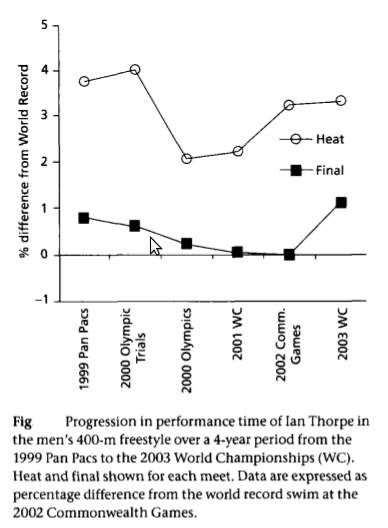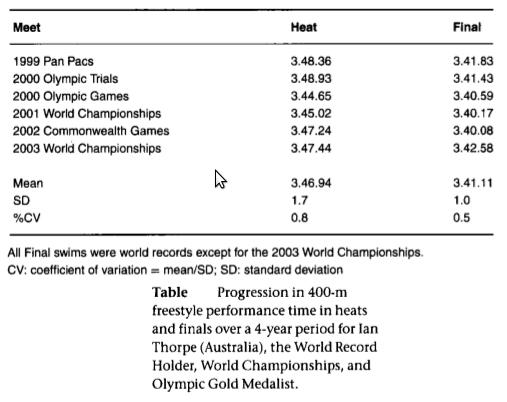 The championship season is all about competitive performance rather than responses to training. Estimates of progression and variability of performance in competitions are useful for coaches, swimmers, and researchers interested in factors affecting performance (Hopkins et al. 1999; Trewin et al. 2004).
The championship season is all about competitive performance rather than responses to training. Estimates of progression and variability of performance in competitions are useful for coaches, swimmers, and researchers interested in factors affecting performance (Hopkins et al. 1999; Trewin et al. 2004).
Progressions are generally required to ensure that a swimmer qualifies for the semifinal and then the final in a given event, and that peak performance is produced in the final, where medals are decided. Performance evaluations of this type for leading swimmers provide some insight into the variability and progression of performance of both individuals and teams (Stewart & Hopkins 2000). This information also assists swimmers and coaches in the planning process.
The utility of these estimates was examined in swimmers of the world's top two swimming nations competing in the 2000 Olympic Games (Pyne et al. in press). Official race times (n = 676) of 26 US and 25 Australian Olympic swimmers who competed in the 1999 Pan Pacific Championships, the 2000 Olympic Trials, and the 2000 Olympic Games were analyzed.
Within each competition, both nations showed similar improvements of 1.2% in mean performance time from heats through finals. Mean competition time improved in the 12 months between the Pan Pacifics and Olympics by approximately 0.9%. The typical variation in performance time for a swimmer between races was 0.6% within a competition and 0.8% between competitions. Sex and swimming distance appeared to have minor or negligible effects on progression and variability. These findings suggest that an Olympic swimmer has to improve performance by -1% within a competition to stay in contention for a medal and by -1% within the year leading to the Olympics.
The variation in performance from race to race is an important determinant of a swimmer's chances of winning the race. A swimmer in contention for a medal has to improve his or her performance by approximately half the typical race-to-race variation in performance (expressed as a standard deviation) to substantially increase their chance of success. However, other swimmers may also improve their performance between competitions, so a given swimmer will need to improve by an additional amount approximately equal to the mean progression of all the competitors to remain in contention. An example of progressions in performance time for the 2000 Olympic and 2001 and 2003 World Champion lan Thorpe (Australia) in the 400-m freestyle is shown in Fig and Table

Fig Progression in performance time of lan Thorpe in the men's 400-m freestyle over a 4-year period from the 1999 Pan Pacs to the 2003 World Championships (WC). Heat and final shown for each meet. Data are expressed as percentage difference from the world record swim at the 2002 Commonwealth Games.

